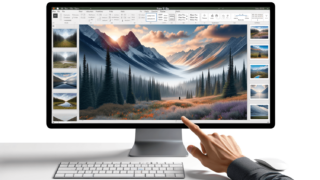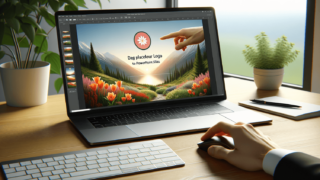
How to Add a Background Image in PowerPoint?
Written by: Bill Whitman
Last updated:

How to Add a Background Image in PowerPoint
Adding a background image in PowerPoint can transform a mundane presentation into a visually appealing showcase. Whether you’re looking to brand your company presentation or make educational slides more engaging, understanding how to manipulate backgrounds is essential.
Category: PowerPoint Tutorials
Step-by-Step Guide
1. Select the Slide
– Open your PowerPoint presentation and click on the slide where you want to add a background image.
– Ensure that no objects on the slide are selected.
2. Insert the Background Image
– Right-click on a blank area of the slide and select ‘Format Background’ from the context menu.
– Click on ‘Picture or texture fill’ then ‘File…’ to choose an image from your computer.
– Alternatively, you can drag and drop an image directly from your computer into the PowerPoint slide.
3. Adjust the Image
– Once the image is loaded, adjust its transparency if desired using the ‘Transparency’ slider under the ‘Format Background’ options.
– Use the ‘Tile picture as texture’ option if you need to repeat the image across the slide.
– To make changes to the entire presentation, click on ‘Apply to All’ at the bottom of the ‘Format Background’ pane.
4. Finalize and Review
– Review the slide or presentation to ensure the background meets your needs.
– Save your PowerPoint file to preserve the changes.
Pro Tips
- Opt for High-Quality Images: Use high-resolution images to prevent pixilation, especially if the presentation will be displayed on large screens.
- Shortcut: Press
Alt + G, Bto quickly open the ‘Format Background’ dialog box. - Maintain Consistency: If you apply a background to one slide, consider applying it to all for a uniform look.
Troubleshooting Common Issues
| Image Stretches Improperly | Make sure the aspect ratio of the image matches the slide’s aspect ratio, or use ‘Tile picture as texture’ instead of stretching the image. |
| Background Not Visible | Check if there are any full-page objects covering the background. Bring background objects to the front. |
Advanced Techniques
- Layer Multiple Images: Use transparency and layering to create a collage of images as a slide background for dynamic visual effects.
- Animated Backgrounds: Consider subtle animations for static images by using PowerPoint’s animation features to enhance engagement.
Compatibility Notes
These steps are applicable to PowerPoint 2016 and newer versions. For other presentation software like Google Slides, the steps may vary slightly, primarily in accessing background settings.
Conclusion
Adding a background image is just the start! Experiment with different images and settings to discover what best enhances your presentation. Explore related features like adding transitions and animations next to fully engage your audience.
Remember, at LearnPowerPoint.io, we are dedicated to helping you master all aspects of PowerPoint to create stunning presentations.
FAQ
Q: Can I use any image as a background?
A: Yes, but ensure that the image resolution and aspect ratio fit the slide to maintain quality across different screen sizes.
Q: How can I remove a background image?
A: Go to ‘Format Background’ and select ‘Solid fill’ or choose ‘Reset Background’ to revert to the default slide background.
Q: Is there a way to apply a background to specific slides only?
A: Yes, you can apply different backgrounds by selecting each slide individually and repeating the background setting process.
Featured Posts
- No pillar pages found.








